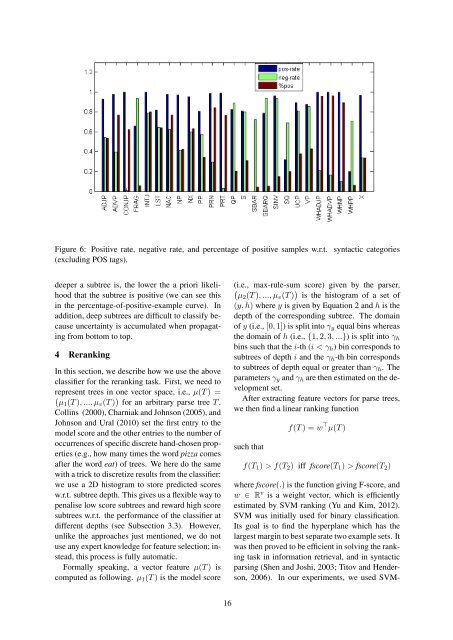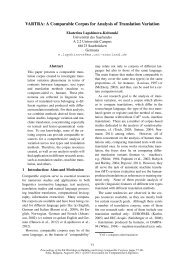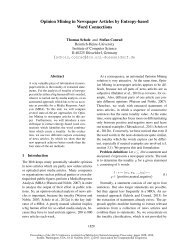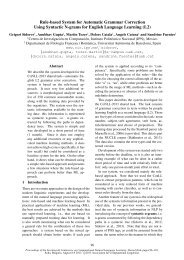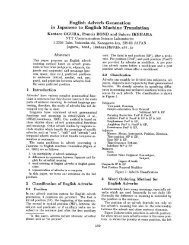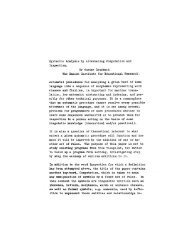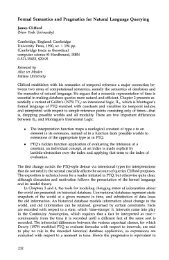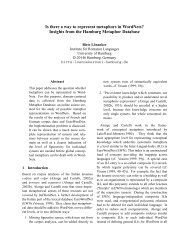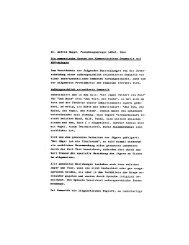Vector Space Semantic Parsing: A Framework for Compositional ...
Vector Space Semantic Parsing: A Framework for Compositional ...
Vector Space Semantic Parsing: A Framework for Compositional ...
You also want an ePaper? Increase the reach of your titles
YUMPU automatically turns print PDFs into web optimized ePapers that Google loves.
Figure 6: Positive rate, negative rate, and percentage of positive samples w.r.t. syntactic categories<br />
(excluding POS tags).<br />
deeper a subtree is, the lower the a priori likelihood<br />
that the subtree is positive (we can see this<br />
in the percentage-of-positive-example curve). In<br />
addition, deep subtrees are difficult to classify because<br />
uncertainty is accumulated when propagating<br />
from bottom to top.<br />
4 Reranking<br />
In this section, we describe how we use the above<br />
classifier <strong>for</strong> the reranking task. First, we need to<br />
represent<br />
(<br />
trees in one vector space, i.e., µ(T ) =<br />
µ1 (T ), ..., µ v (T ) ) <strong>for</strong> an arbitrary parse tree T .<br />
Collins (2000), Charniak and Johnson (2005), and<br />
Johnson and Ural (2010) set the first entry to the<br />
model score and the other entries to the number of<br />
occurrences of specific discrete hand-chosen properties<br />
(e.g., how many times the word pizza comes<br />
after the word eat) of trees. We here do the same<br />
with a trick to discretize results from the classifier:<br />
we use a 2D histogram to store predicted scores<br />
w.r.t. subtree depth. This gives us a flexible way to<br />
penalise low score subtrees and reward high score<br />
subtrees w.r.t. the per<strong>for</strong>mance of the classifier at<br />
different depths (see Subsection 3.3). However,<br />
unlike the approaches just mentioned, we do not<br />
use any expert knowledge <strong>for</strong> feature selection; instead,<br />
this process is fully automatic.<br />
Formally speaking, a vector feature µ(T ) is<br />
computed as following. µ 1 (T ) is the model score<br />
(i.e., max-rule-sum score) given by the parser,<br />
(<br />
µ2 (T ), ..., µ v (T ) ) is the histogram of a set of<br />
(y, h) where y is given by Equation 2 and h is the<br />
depth of the corresponding subtree. The domain<br />
of y (i.e., [0, 1]) is split into γ y equal bins whereas<br />
the domain of h (i.e., {1, 2, 3, ...}) is split into γ h<br />
bins such that the i-th (i < γ h ) bin corresponds to<br />
subtrees of depth i and the γ h -th bin corresponds<br />
to subtrees of depth equal or greater than γ h . The<br />
parameters γ y and γ h are then estimated on the development<br />
set.<br />
After extracting feature vectors <strong>for</strong> parse trees,<br />
we then find a linear ranking function<br />
such that<br />
f(T ) = w ⊤ µ(T )<br />
f(T 1 ) > f(T 2 ) iff fscore(T 1 ) > fscore(T 2 )<br />
where fscore(.) is the function giving F-score, and<br />
w ∈ R v is a weight vector, which is efficiently<br />
estimated by SVM ranking (Yu and Kim, 2012).<br />
SVM was initially used <strong>for</strong> binary classification.<br />
Its goal is to find the hyperplane which has the<br />
largest margin to best separate two example sets. It<br />
was then proved to be efficient in solving the ranking<br />
task in in<strong>for</strong>mation retrieval, and in syntactic<br />
parsing (Shen and Joshi, 2003; Titov and Henderson,<br />
2006). In our experiments, we used SVM-<br />
16


